Beier Zhu
Detail++: Training-Free Detail Enhancer for Text-to-Image Diffusion Models
Jul 23, 2025Abstract:Recent advances in text-to-image (T2I) generation have led to impressive visual results. However, these models still face significant challenges when handling complex prompt, particularly those involving multiple subjects with distinct attributes. Inspired by the human drawing process, which first outlines the composition and then incrementally adds details, we propose Detail++, a training-free framework that introduces a novel Progressive Detail Injection (PDI) strategy to address this limitation. Specifically, we decompose a complex prompt into a sequence of simplified sub-prompts, guiding the generation process in stages. This staged generation leverages the inherent layout-controlling capacity of self-attention to first ensure global composition, followed by precise refinement. To achieve accurate binding between attributes and corresponding subjects, we exploit cross-attention mechanisms and further introduce a Centroid Alignment Loss at test time to reduce binding noise and enhance attribute consistency. Extensive experiments on T2I-CompBench and a newly constructed style composition benchmark demonstrate that Detail++ significantly outperforms existing methods, particularly in scenarios involving multiple objects and complex stylistic conditions.
Unsupervised Visual Chain-of-Thought Reasoning via Preference Optimization
Apr 25, 2025Abstract:Chain-of-thought (CoT) reasoning greatly improves the interpretability and problem-solving abilities of multimodal large language models (MLLMs). However, existing approaches are focused on text CoT, limiting their ability to leverage visual cues. Visual CoT remains underexplored, and the only work is based on supervised fine-tuning (SFT) that relies on extensive labeled bounding-box data and is hard to generalize to unseen cases. In this paper, we introduce Unsupervised Visual CoT (UV-CoT), a novel framework for image-level CoT reasoning via preference optimization. UV-CoT performs preference comparisons between model-generated bounding boxes (one is preferred and the other is dis-preferred), eliminating the need for bounding-box annotations. We get such preference data by introducing an automatic data generation pipeline. Given an image, our target MLLM (e.g., LLaVA-1.5-7B) generates seed bounding boxes using a template prompt and then answers the question using each bounded region as input. An evaluator MLLM (e.g., OmniLLM-12B) ranks the responses, and these rankings serve as supervision to train the target MLLM with UV-CoT by minimizing negative log-likelihood losses. By emulating human perception--identifying key regions and reasoning based on them--UV-CoT can improve visual comprehension, particularly in spatial reasoning tasks where textual descriptions alone fall short. Our experiments on six datasets demonstrate the superiority of UV-CoT, compared to the state-of-the-art textual and visual CoT methods. Our zero-shot testing on four unseen datasets shows the strong generalization of UV-CoT. The code is available in https://github.com/kesenzhao/UV-CoT.
Project-Probe-Aggregate: Efficient Fine-Tuning for Group Robustness
Mar 12, 2025Abstract:While image-text foundation models have succeeded across diverse downstream tasks, they still face challenges in the presence of spurious correlations between the input and label. To address this issue, we propose a simple three-step approach,Project-Probe-Aggregate (PPA), that enables parameter-efficient fine-tuning for foundation models without relying on group annotations. Building upon the failure-based debiasing scheme, our method, PPA, improves its two key components: minority samples identification and the robust training algorithm. Specifically, we first train biased classifiers by projecting image features onto the nullspace of class proxies from text encoders. Next, we infer group labels using the biased classifier and probe group targets with prior correction. Finally, we aggregate group weights of each class to produce the debiased classifier. Our theoretical analysis shows that our PPA enhances minority group identification and is Bayes optimal for minimizing the balanced group error, mitigating spurious correlations. Extensive experimental results confirm the effectiveness of our PPA: it outperforms the state-of-the-art by an average worst-group accuracy while requiring less than 0.01% tunable parameters without training group labels.
Generalized Kullback-Leibler Divergence Loss
Mar 11, 2025Abstract:In this paper, we delve deeper into the Kullback-Leibler (KL) Divergence loss and mathematically prove that it is equivalent to the Decoupled Kullback-Leibler (DKL) Divergence loss that consists of (1) a weighted Mean Square Error (wMSE) loss and (2) a Cross-Entropy loss incorporating soft labels. Thanks to the decoupled structure of DKL loss, we have identified two areas for improvement. Firstly, we address the limitation of KL loss in scenarios like knowledge distillation by breaking its asymmetric optimization property along with a smoother weight function. This modification effectively alleviates convergence challenges in optimization, particularly for classes with high predicted scores in soft labels. Secondly, we introduce class-wise global information into KL/DKL to reduce bias arising from individual samples. With these two enhancements, we derive the Generalized Kullback-Leibler (GKL) Divergence loss and evaluate its effectiveness by conducting experiments on CIFAR-10/100, ImageNet, and vision-language datasets, focusing on adversarial training, and knowledge distillation tasks. Specifically, we achieve new state-of-the-art adversarial robustness on the public leaderboard -- RobustBench and competitive knowledge distillation performance across CIFAR/ImageNet models and CLIP models, demonstrating the substantial practical merits. Our code is available at https://github.com/jiequancui/DKL.
StyleStudio: Text-Driven Style Transfer with Selective Control of Style Elements
Dec 11, 2024Abstract:Text-driven style transfer aims to merge the style of a reference image with content described by a text prompt. Recent advancements in text-to-image models have improved the nuance of style transformations, yet significant challenges remain, particularly with overfitting to reference styles, limiting stylistic control, and misaligning with textual content. In this paper, we propose three complementary strategies to address these issues. First, we introduce a cross-modal Adaptive Instance Normalization (AdaIN) mechanism for better integration of style and text features, enhancing alignment. Second, we develop a Style-based Classifier-Free Guidance (SCFG) approach that enables selective control over stylistic elements, reducing irrelevant influences. Finally, we incorporate a teacher model during early generation stages to stabilize spatial layouts and mitigate artifacts. Our extensive evaluations demonstrate significant improvements in style transfer quality and alignment with textual prompts. Furthermore, our approach can be integrated into existing style transfer frameworks without fine-tuning.
Devils in Middle Layers of Large Vision-Language Models: Interpreting, Detecting and Mitigating Object Hallucinations via Attention Lens
Nov 23, 2024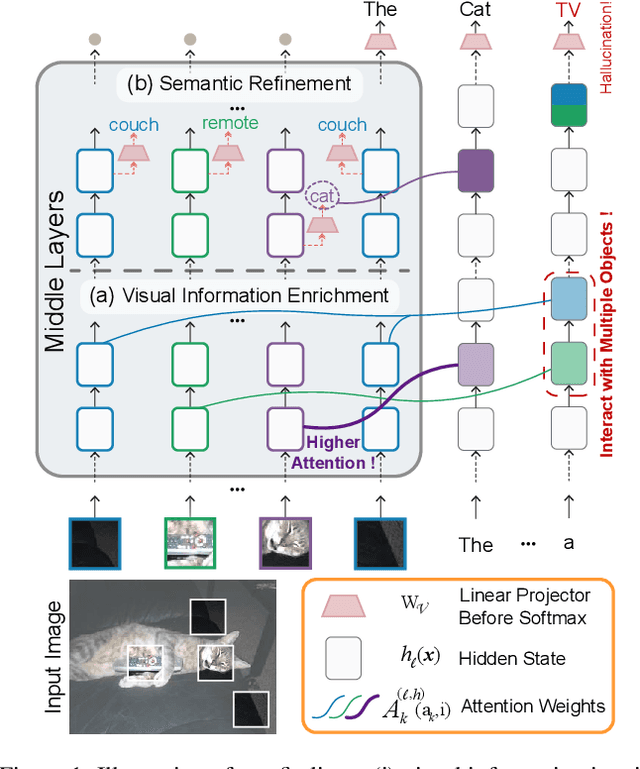

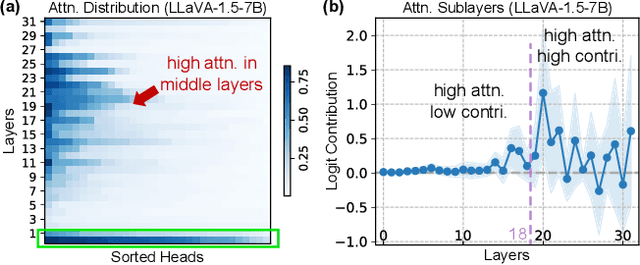

Abstract:Hallucinations in Large Vision-Language Models (LVLMs) significantly undermine their reliability, motivating researchers to explore the causes of hallucination. However, most studies primarily focus on the language aspect rather than the visual. In this paper, we address how LVLMs process visual information and whether this process causes hallucination. Firstly, we use the attention lens to identify the stages at which LVLMs handle visual data, discovering that the middle layers are crucial. Moreover, we find that these layers can be further divided into two stages: "visual information enrichment" and "semantic refinement" which respectively propagate visual data to object tokens and interpret it through text. By analyzing attention patterns during the visual information enrichment stage, we find that real tokens consistently receive higher attention weights than hallucinated ones, serving as a strong indicator of hallucination. Further examination of multi-head attention maps reveals that hallucination tokens often result from heads interacting with inconsistent objects. Based on these insights, we propose a simple inference-time method that adjusts visual attention by integrating information across various heads. Extensive experiments demonstrate that this approach effectively mitigates hallucinations in mainstream LVLMs without additional training costs.
Robust Fine-tuning of Zero-shot Models via Variance Reduction
Nov 11, 2024



Abstract:When fine-tuning zero-shot models like CLIP, our desideratum is for the fine-tuned model to excel in both in-distribution (ID) and out-of-distribution (OOD). Recently, ensemble-based models (ESM) have been shown to offer significant robustness improvement, while preserving high ID accuracy. However, our study finds that ESMs do not solve the ID-OOD trade-offs: they achieve peak performance for ID and OOD accuracy at different mixing coefficients. When optimized for OOD accuracy, the ensemble model exhibits a noticeable decline in ID accuracy, and vice versa. In contrast, we propose a sample-wise ensembling technique that can simultaneously attain the best ID and OOD accuracy without the trade-offs. Specifically, we construct a Zero-Shot Failure (ZSF) set containing training samples incorrectly predicted by the zero-shot model. For each test sample, we calculate its distance to the ZSF set and assign a higher weight to the fine-tuned model in the ensemble if the distance is small. We term our method Variance Reduction Fine-tuning (VRF), as it effectively reduces the variance in ensemble predictions, thereby decreasing residual error. On ImageNet and five derived distribution shifts, our VRF further improves the OOD accuracy by 1.5 - 2.0 pp over the ensemble baselines while maintaining or increasing ID accuracy. VRF achieves similar large robustness gains (0.9 - 3.1 pp) on other distribution shifts benchmarks. Codes are available in https://github.com/BeierZhu/VRF.
Enhancing Zero-Shot Vision Models by Label-Free Prompt Distribution Learning and Bias Correcting
Oct 25, 2024

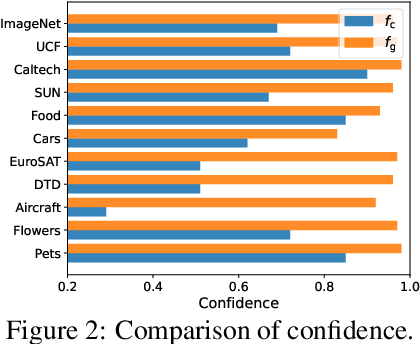

Abstract:Vision-language models, such as CLIP, have shown impressive generalization capacities when using appropriate text descriptions. While optimizing prompts on downstream labeled data has proven effective in improving performance, these methods entail labor costs for annotations and are limited by their quality. Additionally, since CLIP is pre-trained on highly imbalanced Web-scale data, it suffers from inherent label bias that leads to suboptimal performance. To tackle the above challenges, we propose a label-Free prompt distribution learning and bias correction framework, dubbed as **Frolic**, which boosts zero-shot performance without the need for labeled data. Specifically, our Frolic learns distributions over prompt prototypes to capture diverse visual representations and adaptively fuses these with the original CLIP through confidence matching. This fused model is further enhanced by correcting label bias via a label-free logit adjustment. Notably, our method is not only training-free but also circumvents the necessity for hyper-parameter tuning. Extensive experimental results across 16 datasets demonstrate the efficacy of our approach, particularly outperforming the state-of-the-art by an average of $2.6\%$ on 10 datasets with CLIP ViT-B/16 and achieving an average margin of $1.5\%$ on ImageNet and its five distribution shifts with CLIP ViT-B/16. Codes are available in https://github.com/zhuhsingyuu/Frolic.
Selective Vision-Language Subspace Projection for Few-shot CLIP
Jul 26, 2024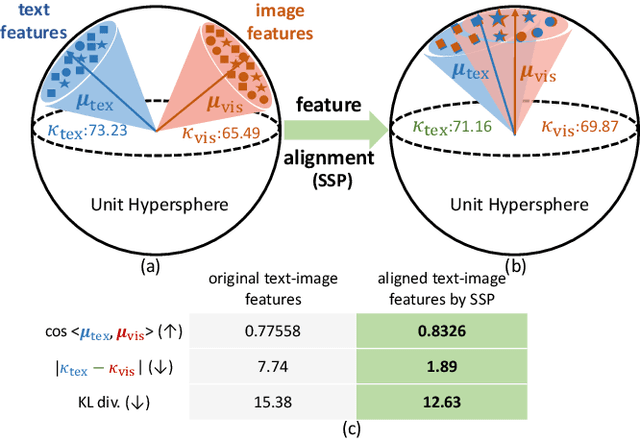
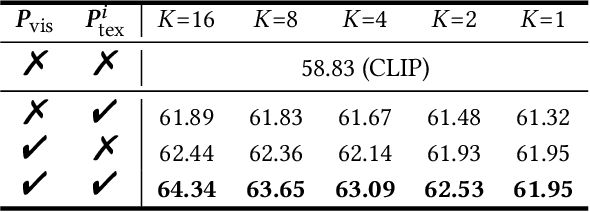
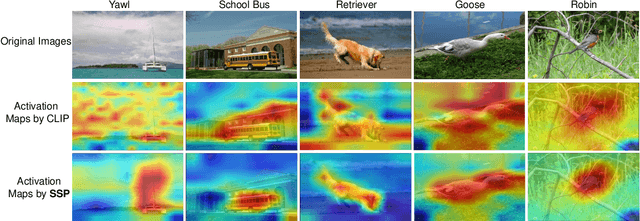
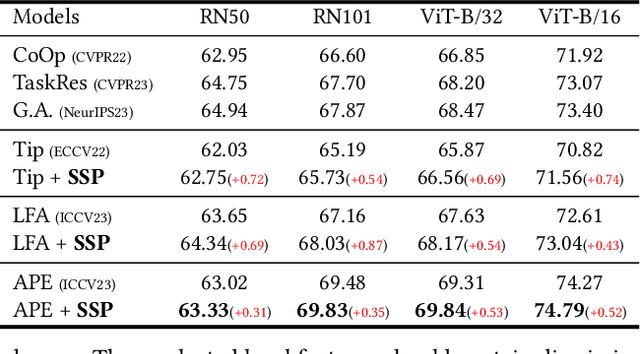
Abstract:Vision-language models such as CLIP are capable of mapping the different modality data into a unified feature space, enabling zero/few-shot inference by measuring the similarity of given images and texts. However, most existing methods overlook modality gaps in CLIP's encoded features, which is shown as the text and image features lie far apart from each other, resulting in limited classification performance. To tackle this issue, we introduce a method called Selective Vision-Language Subspace Projection (SSP), which incorporates local image features and utilizes them as a bridge to enhance the alignment between image-text pairs. Specifically, our SSP framework comprises two parallel modules: a vision projector and a language projector. Both projectors utilize local image features to span the respective subspaces for image and texts, thereby projecting the image and text features into their respective subspaces to achieve alignment. Moreover, our approach entails only training-free matrix calculations and can be seamlessly integrated into advanced CLIP-based few-shot learning frameworks. Extensive experiments on 11 datasets have demonstrated SSP's superior text-image alignment capabilities, outperforming the state-of-the-art alignment methods. The code is available at https://github.com/zhuhsingyuu/SSP
Classes Are Not Equal: An Empirical Study on Image Recognition Fairness
Mar 13, 2024Abstract:In this paper, we present an empirical study on image recognition fairness, i.e., extreme class accuracy disparity on balanced data like ImageNet. We experimentally demonstrate that classes are not equal and the fairness issue is prevalent for image classification models across various datasets, network architectures, and model capacities. Moreover, several intriguing properties of fairness are identified. First, the unfairness lies in problematic representation rather than classifier bias. Second, with the proposed concept of Model Prediction Bias, we investigate the origins of problematic representation during optimization. Our findings reveal that models tend to exhibit greater prediction biases for classes that are more challenging to recognize. It means that more other classes will be confused with harder classes. Then the False Positives (FPs) will dominate the learning in optimization, thus leading to their poor accuracy. Further, we conclude that data augmentation and representation learning algorithms improve overall performance by promoting fairness to some degree in image classification. The Code is available at https://github.com/dvlab-research/Parametric-Contrastive-Learning.
 Add to Chrome
Add to Chrome Add to Firefox
Add to Firefox Add to Edge
Add to Edge